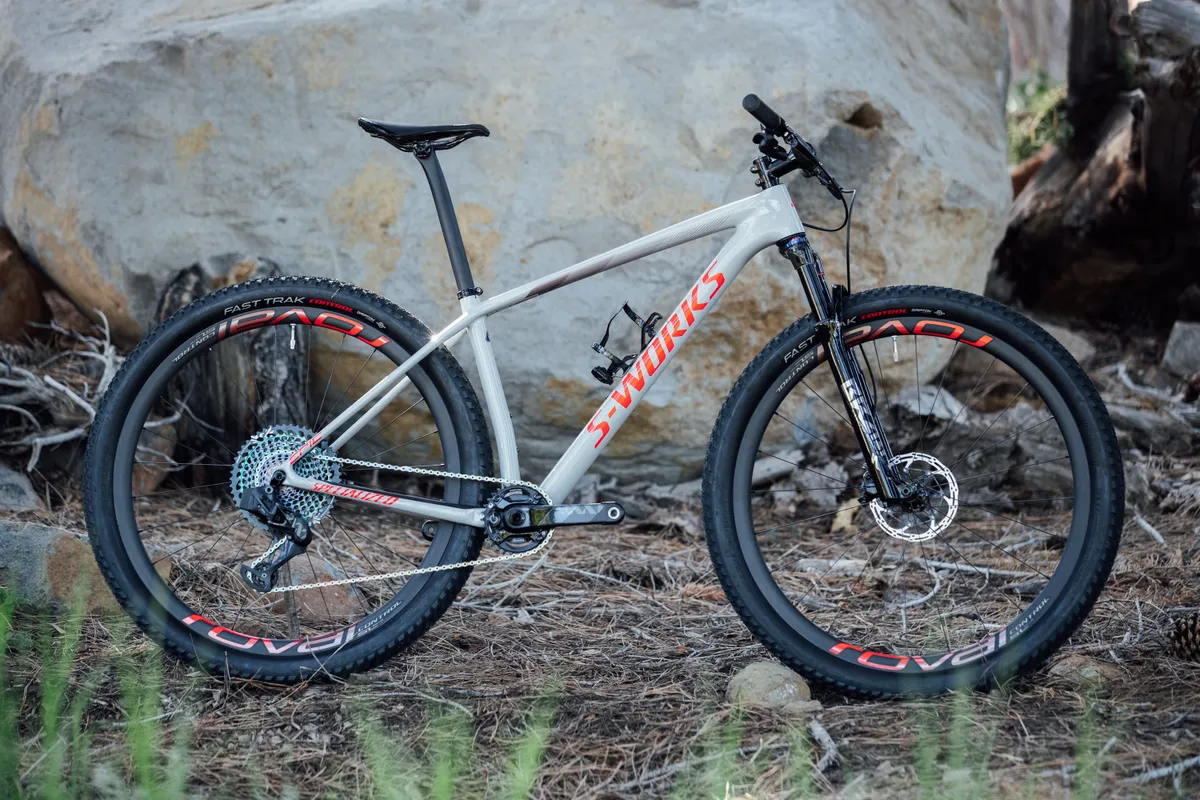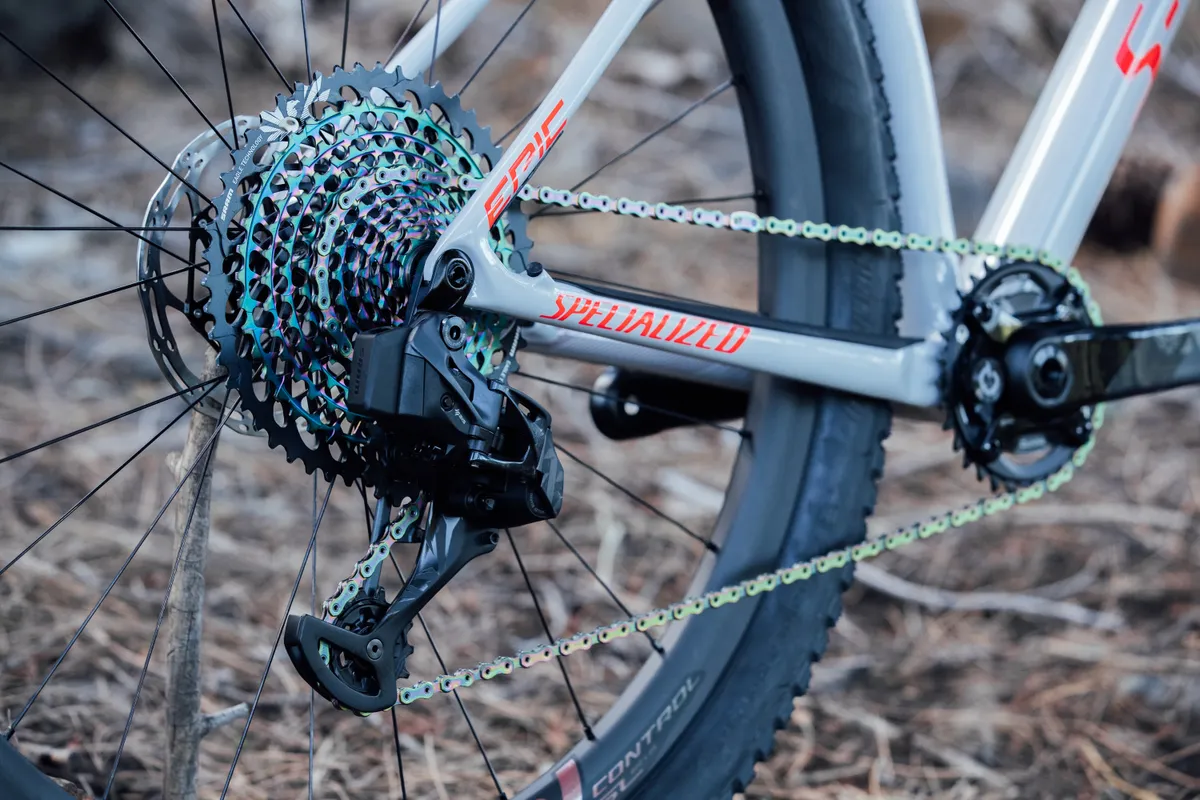The Specialized Epic has to be one of the classic cross-country race bikes, and for 2020 Specialized has given it a complete overhaul to drop the claimed frame weight to less than 800g.
Weight is still a massive consideration when it comes to cross-country racing, which is why Specialized says it's spent a lot of time and engineering resource shaving weight wherever possible from the Epic HT. The result, based on my brief time on the Epic at its launch, is a bike that certainly won't hold you back on the climbs - read on for my initial first ride impressions.
The top-end S-Works frame boasts a 790g frame weight (manufacturing variances actually give weights between 760–790g), resulting in a claimed 7.8kg build weight (£8,000 / £9,150), while the base level bikes, which start at £2,250 / $2,110, still benefit from a sub-kilo frame, with their FACT 11 frames weighing in at a claimed 930g.
However, that's not the only area that sees updates. Virtually market-wide, we're seeing a move towards more 'aggressive' race tracks, which has meant that even cross-country racers aren't immune from the long, low and slack treatment — as well as giving more thought to how stiff a bike's chassis needs to be.

As a result of gnarlier tracks, bikes need to have 'better' handling so that racers are able to push on the descents. A nervous, super-stiff, upright twitchy bike is never going to hold its ground when competing down rough, rocky and rooty tracks, such as at Nove Mesto.
Another reason for this change in geometry and design, according to Specialized, is that an 'easier' bike to handle lets its riders rest more on descents, leaving them in better shape to attack the climbs.
This has all led Specialized to design what it claims is the lightest, most capable XC bike on the market. It's still race-focussed, but Specialized reckons marathon racers will appreciate the added comfort, and the changes to geometry should make it even more useable as a day-to-day bike for regular riders, too.
Epic weight shaving
Getting a frame down to this weight takes a fair bit of engineering. Specialized employed 3D modelling technology (as most brands probably do to some extent) to cut down on material usage in the frame: less material equals less weight.
One area that Specialized worked on was the overlap of different sheets of prepreg carbon fibre. With computer modelling, it was able to work out the minimum overlap required to maintain the strength and stiffness needed, without using excess material. Furthermore, keeping the insides of the tubes as smooth as possible also reduces material usage.

When it comes to the tube junctions, Specialized reckons that, in certain areas, less is more. It told us that smaller interfaces can be just as stiff if engineered properly, while also being lighter. This is why the frame has a particular skinny look to it, especially at the bottom bracket junction and where the seatstays meet the seat tube.
The same focus was also given to the type of carbon used. Thirty different types of carbon fibre feature in the frame, with different carbon and resin compositions.
Carbon with less resin in the sheet tends to be stiffer and lighter, but less impact resistant, so these have been placed in appropriate areas to help reduce weight.

Finally, little details such as the cable routing have been optimised, according to Specialized. The hose and cable guide entries are all moulded as part of the frame (so no bolt-in cable guides), which saves weight, as does the elimination of aluminium inserts at the dropouts.
You also get a co-moulded aluminium threaded bottom bracket insert, which is no heavier than the effective block of carbon used when making a press-fit bottom bracket shell. It is also, ultimately, more user-friendly.
Specialized Epic geometry improvements
Longer and slacker is the name of the game here, which is also the case across the entire mountain bike spectrum.
In a size large the Epic has a reach of 455mm, which is relatively long for a thoroughbred XC bike, and a head angle of 68.5 degrees, which is 1.3 degrees slacker than the previous model.

Longer, slacker bikes, in conjunction with the shorter 42mm offset fork (51mm previously), should help to calm down handling for an easier ride on technical terrain.
This has been done in conjunction with running shorter stems (60–75mm) to ensure handling doesn't end up too lazy.

Conversely, Specialized said it didn't want to make the Epic into a barge, so the shorter offset fork helps keep the wheelbase relatively snappy at 1,146mm in a size large.
The seat tube sits at 74 degrees, while the bottom bracket lies 63mm below the axles at a height of 309mm. Chainstays are 430mm, and the size large seat tube is 470mm with a stack of 622mm.
Comfort is key
Specialized's product testing included 15 frames with slightly different builds, which were ridden by a number of testers to get the feel of the frame fine-tuned.
In the end, Specialized went for a slightly stiffer front triangle, which gives precise handling and makes it easier to haul on the bars when climbing, with a slightly softer back end.
This provides more compliance and comfort, and also helps keep the rear wheel stuck to the ground; stiffer frames tend to get a bit pingy through rocks and round rough corners.

The seat tube has a 30.9mm diameter, so is dropper post ready. The slight curve, in addition to the thinner seatstays, adds compliance, according to Specialized, so no comfort is apparently lost over the previous, skinnier-posted Epic.
Bikes are specced with 2.3in tyres and there's plenty of clearance for mud.
Specialized Epic models
Specialized Epic HT S-Works SRAM AXS
- £8,000 / $9,150
This is the top-end Epic model and comes with the sub-800g S-Works frame, a Brain-controlled SID Ultimate fork and SRAM's 12-speed wireless AXS drivetrain.

Specialized Epic HT Expert Carbon
- £4,250 / $4,310
With a sub-kilo frame, the Expert level Epic comes with a RockShox SID, and features Brain damping and a SRAM GX Eagle drivetrain.

Specialized Epic HT Comp Carbon
- £2,750 / $2,610
The Comp Carbon has an NX Eagle drivetrain and a RockShox Reba RL fork.

Specialized Epic HT Carbon
- £2,250 / $2,110
The entry-level Epic still gets a sub-kilo carbon frameset and relies on a SRAM SX Eagle groupset and RockShox' Judy Gold fork.

US Specialized Epic HT models
Our lucky US readers get a few extra models that don't appear to be being imported into the UK.
Specialized Epic HT Pro
- $5,510
- RockShox SID Brain, SRAM X01 Eagle
Specialized S-Works Epic HT XTR
- $8,510
- RockShox SID Brain Ultimate, Shimano XTR 12-speed groupset
Specialized S-Works Epic HT Ultralight
- $9,210
- Fox 32 StepCast, Magura MT8 brakes, SRAM XX1 drivetrain
Specialized S-Works Epic HT AXS / Quark
- $9,510
- Spec of the S-Works Epic AXS but with a Quark power meter as standard
Specialized S-Works Epic HT frameset
- $2,500
- The 790g frame is available for your own custom build
Specialized S-Works Epic HT AXS first ride impressions
During the bike's launch, I rode the top-level Specialized S-Works Epic HT AXS on unfamiliar tracks near Lake Tahoe for about four hours, so these are only very brief, initial ride impressions. I hope to get a bike in for a thorough test soon though.

With a very light build, it was no surprise that the bike felt lively riding up fire road climbs. While it's clichèd to say, it really did feel like every watt of power was going to the rear wheel and being converted into very effective forward movement.
Traction was reasonable, but in loose, dusty conditions the Fast Track tyres were never going to be the grippiest option. Still, 500m of climbing on the Epic felt a lot friendlier than other 500m climbs I've done in the past.

Once the Epic got flowing on singletrack it was rather fun, in its own 'head's down XC racer' kind of way. No hardtail is ever going to give you the comfiest ride, but with 2.3in tyres and the additional compliance of the new bike, the Epic isn't as harsh as some other pure cross-country bikes I've ridden.
On smooth trails the bike seemed to zip along very, very happily. Handling was fairly calm, and despite the rain coming in and the rocks getting wet, I certainly felt comfortable letting go of the brakes.
When things got rougher the bike encouraged you up and over obstacles, maintaining a resemblance of flow. Like all hardtails, you have to work the bike more to maintain speed, but if speed was lost, a quick kick of the pedals got it all back up and running again.

The Brain-controlled SID fork was also fairly impressive. The system opens the damping when impacts are detected and closes it when things are running smooth.
There's an adjustment on the top of the fork to change the threshold of how it reacts, and there's a noticeable difference at either end of the scale.
I ran it open the majority of the time, which only really let it stay closed on smooth road and fire road drags, leaving it open during pretty much the whole descent.

With such limited time on the bike, it's hard to give a thorough first ride review. But initial impressions do count, and I think Specialized is on to something with the Epic.
It's not a bone-shaker, nor is it terrifying as soon as the gradient gets below horizontal. When the trail kicks up, the Epic is certainly going to be a long way down your list of excuses for not smashing every KOM/QOM going.
